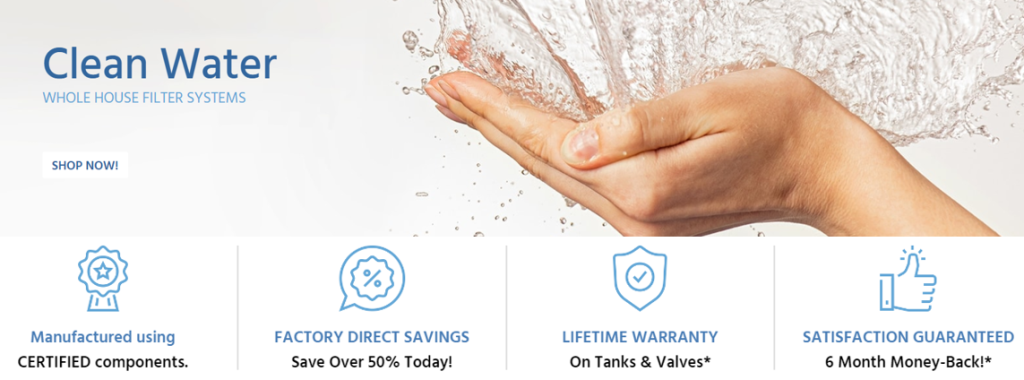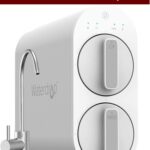Water softeners remove iron by exchanging the iron for sodium ions.
In the early 1900s, a Milwaukee-based engineer named J.L. Muhlenberg developed the first modern water softener. His design used sodium chloride (salt) to remove magnesium and calcium from water, making it softer. Muhlenberg’s design was so effective that it is still used in many water softeners today.
How Does A Water Softener Remove Iron From Water?
A water softener removes iron from water by exchanging the iron for sodium on the resin beads.

Water softeners are devices that are installed in homes to remove certain minerals from the water supply, such as calcium, magnesium, and iron. These minerals can cause hard water, which can lead to a number of problems such as dry skin, scale buildup on plumbing fixtures, and stained laundry.
Install a Home Water Filter & Get "Unlimited Safe Drinking Water" For Decades
Get Upto 55% Discount With a Lifetime Warranty & 6-Months Money Back Guarantee Free Shipping
SpringWell Water Filtration Systems: 100% American-Made & NSF Certified Water Filters and Water Softeners
While there are many different ways to remove these minerals from water, one of the most common is through the use of a water softener. A water softener works by exchanging the minerals in the water for sodium ions. These sodium ions do not cause the same problems as the other minerals, and they can be easily removed from the water through a process called reverse osmosis.
There are a number of different types of water softeners on the market, but they all work in basically the same way. They all have a resin bed that contains the sodium ions, and a brine solution that is used to regenerate the resin bed.
When the water softener is in use, the hard water passes through the resin bed, and the minerals are exchanged for sodium ions. The sodium ions do not cause any problems, and they are easily removed from the water.
When the resin bed becomes full of minerals, it must be regenerated. This is done by flushing the bed with the brine solution. The brine solution contains a high concentration of salt, which flushes the minerals out of the bed and into the wastewater.
Once the resin bed is regenerated, it is ready to start exchanging minerals again. This process can be repeated indefinitely, and it is an effective way to remove minerals from water.
How Does A Water Softener Work?
A water softener works by exchanging the calcium and magnesium in hard water for sodium.
If you live in an area with hard water, you’re probably all too familiar with the challenges that come along with it. Hard water can cause a number of problems in your home, from scale buildup in your plumbing to dry, itchy skin. A water softener is a device that can help to mitigate these problems by removing the minerals that cause hard water. In this article, we’ll explain how water softeners work and provide a real-life example of how they can benefit your home.
Hard water is water that contains a high concentration of minerals, such as calcium and magnesium. These minerals can cause a number of problems in your home, including:
– Scale buildup in plumbing: Over time, the minerals in hard water can adhere to the walls of your pipes, causing a buildup of scale. This scale can reduce the flow of water through your pipes and, eventually, lead to clogs.
– Dry, itchy skin: When you shower or bathe in hard water, the minerals can strip away natural oils from your skin, leaving it dry and itchy.
– dull hair: Hard water can also deposit minerals on your hair, leading to dullness and split ends.
A water softener is a device that removes the minerals that cause hard water. There are two main types of water softeners: ion exchange and reverse osmosis.
Ion exchange water softeners work by exchanging the minerals in hard water for sodium ions. As water passes through the softener, the minerals are attracted to the sodium ions and adhere to them. The sodium-rich water is then passed through a discharge line into your home.
Reverse osmosis water softeners work by filtering the water to remove the minerals that cause hard water. As water passes through the softener, it is forced through a semipermeable membrane. This membrane allows water molecules to pass through, but traps the minerals that cause hard water. The filtered water is then passed through a discharge line into your home.
Water softeners can be a great way to improve the quality of your water and, as a result, the quality of your life. If you’re considering a water softener for your home, contact a local water treatment professional to learn more about your options.
What Are The Benefits Of Using A Water Softener?
The benefits of using a water softener are that it can remove hardness from water, making it softer and easier to lather.
If you have hard water, then you know the drill: spots on dishes and glassware, dry skin and hair, mineral buildup on fixtures and in appliances, and shortened lifespan of appliances. A water softener can put an end to all of that and more.
What is a water softener? A water softener is a device that removes minerals from water, making it “soft.” The most common minerals removed by water softeners are calcium and magnesium. These minerals are responsible for most of the problems associated with hard water.
How does a water softener work? Water softeners work by exchanging the calcium and magnesium in hard water for sodium or potassium ions. This process is called ion exchange.
During ion exchange, the water softener’s resin beads attract and hold on to the calcium and magnesium ions in the water. At the same time, the sodium or potassium ions are released into the water. The sodium or potassium ions are not attracted to the resin beads, so they remain in the water.
When the resin beads are full of calcium and magnesium ions, the water softener goes through a regeneration process. During regeneration, salt or brine is used to flush the calcium and magnesium ions off of the resin beads and replace them with sodium or potassium ions.
What are the benefits of using a water softener?
There are many benefits of using a water softener, including:
• Softer skin and hair: Hard water can dry out your skin and hair. Soft water can help to reverse this by restoring natural oils and moisture.
• Spot-free dishes and glassware: Hard water leaves spots on dishes and glassware. Soft water eliminates these spots.
• Cleaner laundry: Hard water can cause laundry to appear dingy. Soft water results in brighter and cleaner laundry.
• Longer lasting appliances: Hard water can shorten the lifespan of appliances by causing mineral buildup. Soft water prevents this mineral buildup and extends the life of appliances.
• Reduced energy costs: Appliances that use soft water require less energy to operate. This can lead to lower energy bills.
Is a water softener right for you?
If you’re fed up with hard water problems, then a water softener may be the right solution for you. A water softener can provide all of the benefits listed above, making your life easier and your home healthier.
What Are The Disadvantages Of Using A Water Softener?
Some disadvantages of using a water softener are that they can be expensive to maintain, they can use a lot of salt, and they can sometimes make water feel slimy.
There are a few disadvantages to using a water softener. First, they can be expensive to purchase and install. Second, they require regular maintenance, such as adding salt to the system, to work properly. Third, they can remove beneficial minerals from your water, which some people believe can lead to health problems. Finally, they can waste a lot of water, since they remove minerals that are already in your water supply.
How Often Should A Water Softener Be Used?
A water softener should be used as often as needed to maintain soft water in the home.
If your water contains a lot of minerals, you may need to use a water softener. Water softeners work by exchanging the minerals in your water for sodium ions. This process is known as ion exchange.
The frequency with which you need to use your water softener will depend on the hardness of your water. If you have very hard water, you may need to use it daily. If you have only slightly hard water, you may only need to use it once a week.
You can test the hardness of your water at home with a water hardness test kit. These kits are available at most hardware stores. Once you know the hardness of your water, you can adjust the frequency with which you use your water softener accordingly.
For example, if your water hardness is 10 grains per gallon (gpg), you would need to use your water softener daily. However, if your water hardness is only 5 gpg, you would only need to use your water softener once a week.
If you have hard water, using a water softener can make a big difference. Your clothes will last longer, your dishes will be cleaner, and your hair will be softer. If you have any questions about how often to use your water softener, consult your owner’s manual or contact the manufacturer.
FAQ
How Much Iron Can A Water Softener Remove?
What Are The Consequences Of Not Using A Water Softener?
What Happens If Iron Is Not Removed From Water?
What Are The Symptoms Of Iron Poisoning?
If you are still unclear about how water softeners remove iron, feel free to leave a comment below.


